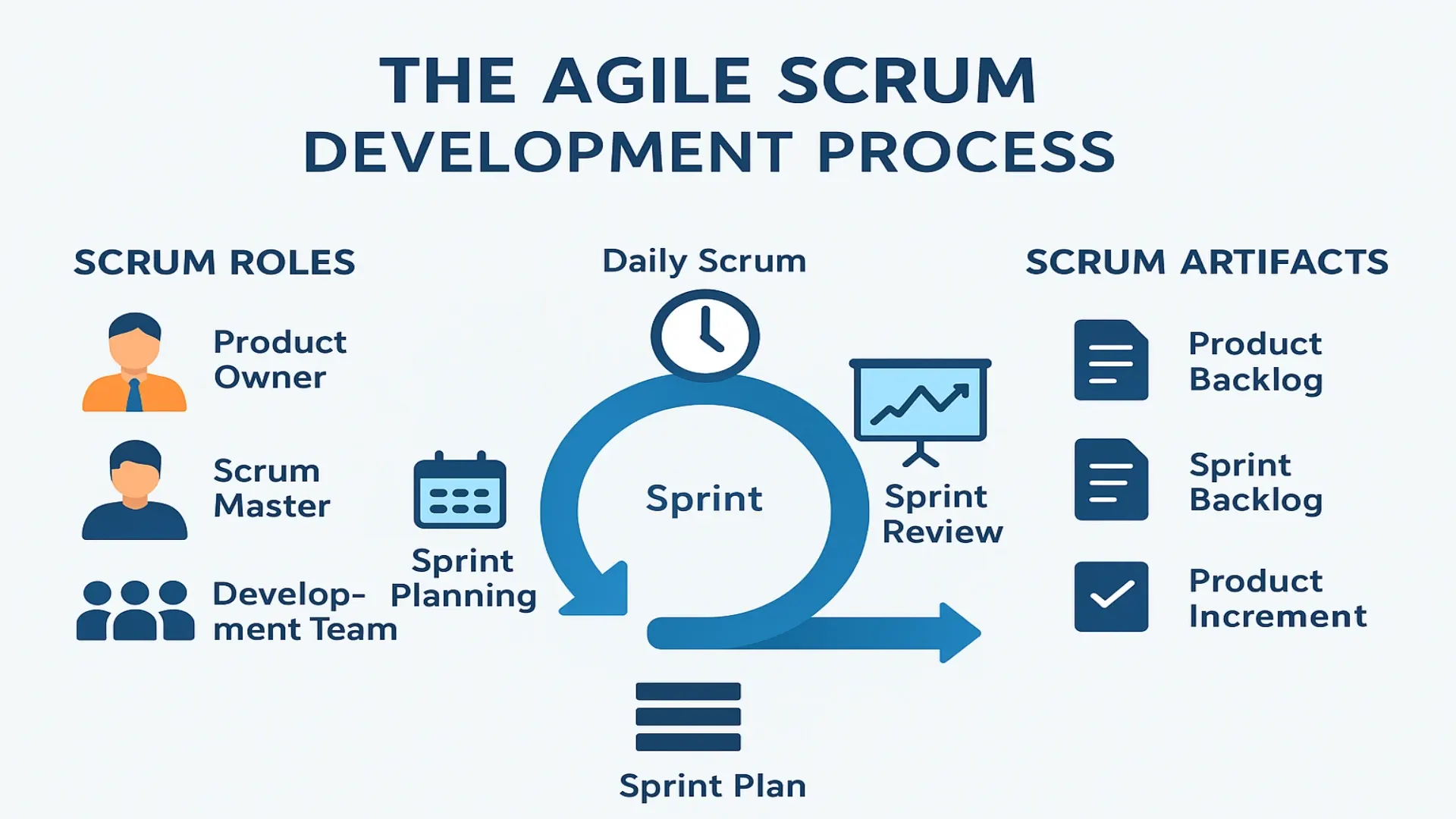What is the Agile Scrum Development Process?

AI Generated. Credit: OpenAI’s ChatGPT
Table of Contents
- The Core Components of Scrum
- Scrum Roles
- Scrum Artifacts
- The Scrum Events (The Sprint Cycle)
- Benefits of Using Scrum
- Scrum vs. Agile: What’s the Difference?
- Conclusion
It is safe to say that the Agile Scrum development process is one of the most popular ways to manage projects in the present times. This is because the Agile methodology sets the mindset, focuses on teamwork and adaptability, and continuous delivery.
Scrum, on the other hand, is the framework that makes Agile practical. It tells teams how to work together, what roles to play, and what events to follow.
So, why do so many companies adopt it? It is because Scrum brings flexibility, faster delivery, better results, and so much more!
In this guide, we will walk you through the Scrum process, look at the roles, artifacts, and events that make it work, and explain why Agile Scrum has become the framework of choice for businesses worldwide.
The Core Components of Scrum
Scrum Roles
Scrum defines three significant roles, and each one of them is vital:
- Product Owner: The Product Owner is the liaison between the customer and the team. They prioritize the Product Backlog and make sure the most valuable work is completed first. Imagine a customer’s voice within the team, which is the Product Owner.
- Scrum Master: More of a guide than a boss, the Scrum Master ensures the team is following Scrum values, helps to resolve issues, and coaches the team to improve. When the team runs into a roadblock, the Scrum Master paves the way.
- Development Team: This refers to the people who create the product. They are self-organizing, which means that they decide how best to do the work, and they are also the ones who are accountable for producing a working increment every sprint.
Artifacts
Scrum artifacts make progress visible and keep everyone aligned:
- Product Backlog: It is a prioritized list of all the tasks, features, and fixes that are needed for the product. It changes over time as new ideas and needs come up.
- Sprint Backlog: This is a smaller list taken from the Product Backlog, which is focused only on what the team commits to deliver during a sprint.
- Product Increment: Lastly, this is the output of a sprint. Each increment must be usable, tested, and ready for stakeholders to see, and over time, these increments add up to the full product.
Custom AI Software Development Solution For Enterprises
The Scrum Events (The Sprint Cycle)
It works through a cycle of time-boxed events. Together, they provide rhythm and accountability:
- The Sprint: It is a fixed duration, commonly two weeks, in which the team works toward creating a working product increment.
- Sprint Planning: At the start of the sprint, the team decides what can be done and how it will be accomplished.
- Daily Scrum (Stand-up): Short, about 15-minute daily meeting where the team checks in, flags problems, and predicts tomorrow.
- Sprint Review: The team showcases the increment to stakeholders at the conclusion of a sprint, and this is also where feedback is garnered.
- Sprint Retrospective: Upon the review, the team discusses what worked, what did not, and how to improve the Scrum process for the following sprint.
Benefits of Using Scrum
Why do companies, be it large or small, trust Agile Scrum? Here are some key advantages:
- Increased Flexibility: Since work is done in short cycles, teams can quickly adapt if there is a change in priorities. This is especially useful in industries like healthcare or finance, where the requirements change on a daily basis.
- Better Collaboration: Scrum roles and events encourage open communication. Team members, stakeholders, and leaders stay on the same page.
- Faster Delivery: Instead of waiting months for a final product, Scrum delivers value in small increments. That means faster time to market.
- Improved Quality: Regular feedback loops help spot issues early. In fact, a 2023 survey showed that 64% of Scrum teams reported better product quality and visibility into progress.
Cloudester Software has seen these benefits in practice. By applying Scrum development for clients, they have helped businesses cut delivery times while boosting innovation.
Scrum vs. Agile: What’s the Difference?
It’s easy to confuse Scrum and Agile, but it can be said with conviction that they’re not the same thing. Agile is the philosophy, nothing short of a set of principles like flexibility, collaboration, and continuous improvement. Scrum is an application of that philosophy.
Think of it this way:
Agile is the “what,” and Scrum is the “how.”
On the one hand, while Agile provides direction through values, Scrum presents a structure through events, roles, and artifacts. Scrum would be just steps without Agile, devoid of direction. Agile values without Scrum might be too theoretical.
Also read: How to Implement Scrum Development: A Complete Guide
Conclusion
Agile Scrum development methodology is more than a buzz; it’s a proven system for addressing complicated projects while delivering value consistently. Its balance of structure and flexibility is perfect for markets from technology to healthcare and beyond.
By embracing the Scrum process, organizations are better able to collaborate, accelerate delivery, and ensure higher quality. Cloudester Software continues to demonstrate how the marriage of Agile methodology and Scrum development creates measurable success and sustainable growth.
If your organization is interested in enhancing project management, begin with Scrum. It might just be the framework that enables your team to work smarter, not harder.









